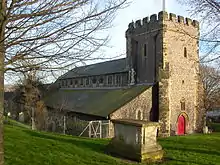Beacon Mill, Rottingdean
Beacon Mill or New Mill is a grade II listed[1] smock mill at Rottingdean, Sussex, England which has been restored as a seamark. It sits within the boundary of the Beacon Hill Local Nature Reserve.
| Rottingdean Windmill | |
|---|---|
 The mill in 2010 | |
| Origin | |
| Mill name | Beacon Mill New Mill |
| Mill location | TQ 366 025 |
| Coordinates | 50°48′22″N 0°03′47″W |
| Operator(s) | Rottingdean Preservation Society |
| Year built | 1802 |
| Information | |
| Purpose | Corn mill |
| Type | Smock mill |
| Storeys | Three-storey smock |
| Base storeys | Single-storey base |
| Smock sides | Eight sides |
| No. of sails | Four sails |
| Type of sails | Patent sails |
| Windshaft | Cast iron |
| Winding | Fantail |


History
Beacon Mill, was built in 1802. There are records of an earlier mill on the site, thought to have been a post mill.[2] During the digging of the foundations, a human skeleton was found[3] of an 'ancient warrior with a sword' but the remains were stolen while the labourers had lunch and have never been recovered.[4] The mill was working until 1881[2] and by 1890 was in such bad condition that demolition was considered.
In 1905, the Marquis of Abergavenny had the mill repaired, but it was derelict again by the early 1920s. It was 1935 before the mill was restored again, the millwrighting being done by Neve's of Heathfield and new sails were made by Holman's, the Canterbury millwrights. In 1969, the mill was leaning to the north east, and Hole's, the Burgess Hill millwrights erected a steel frame inside the smock to support the mill, and fitted new sails.[3] The steel framing was extended into the cap in 1974.[2]
Description
Beacon Mill is a three-storey smock mill on a single-storey brick base. It has a Kentish-style cap, and four Patent sails. It originally had a fantail, but this is now missing.[3]
Culture and Media
The Rottingdean windmill was the inspiration for the trademark (logo) for the publishing house of Heinemann. It was designed by Sir William Nicholson, a Rottingdean resident, and on older Heinemann hardbacks you will see it engraved on the back board of the book. Although Rottingdean Mill was Nicholson's inspiration, he actually traced an older Dutch post-mill as his final design. Updated versions of the windmill are still used for Heinemann publications.
Beacon Mill featured on the front cover of the album "Vale Industrial" by Brighton band The Tenderfoot.[5]
The mill also featured in the music video for That Old Pair of Jeans by Fatboy Slim.
Public access
Beacon Mill is open to the public from 14:00 to 16:30 on both days of National Mills Weekend, and on the third Sunday of each month from May to September.[6]
References
- Historic England. "ROTTINGDEAN WINDMILL AT NGR 365 024, NEVILL ROAD (north off), BRIGHTON, BRIGHTON AND HOVE, EAST SUSSEX (1380100)". National Heritage List for England. Retrieved 11 May 2008.
- The Story of the Rottingdean Windmill. Rottingdean: The Rottingdean Preservation Society. 1977. pp. (leaflet).
- Brunnarius, Martin (1979). The Windmills of Sussex. Chichester: Philimore. pp. 63–64, 190. ISBN 0-85033-345-8.
- "Heritage Gateway - Results". heritagegateway.org.uk. Retrieved 17 March 2021.
- "Rottingdean windmill on album cover". Windmill World. Archived from the original on 14 May 2008. Retrieved 11 May 2008.
- "Rottingdean Windmill". Sussex Mills Group. Retrieved 19 April 2009.
Further reading
Hemming, Peter (1936). Windmills in Sussex. London: C W Daniel. Online version Archived 12 October 2009 at the Wayback Machine
External links
- Windmill World Page on Beacon windmill.
- Rottingdean smock mill, photo gallery
- Rottingdean Village Website More about Rottingdean Village and Shops


.jpg.webp)


.jpg.webp)

